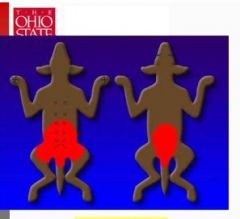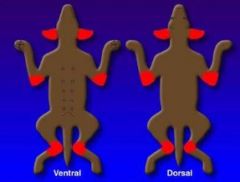![]()
![]()
![]()
Use LEFT and RIGHT arrow keys to navigate between flashcards;
Use UP and DOWN arrow keys to flip the card;
H to show hint;
A reads text to speech;
26 Cards in this Set
- Front
- Back
|
What is pruritus?
|
An unpleasant sensation stimulating the desire to itch
|
|
|
What is skin function modulated by?
|
Neuromediators and peripheral nerves at the periphery
Spinal cord, CNS Immune-endocrine system Autonomic nerves - (Ach) Sensory nerves - neuropeptides, prostanoids and NO |
|
|
What sensory fibers transmit noxious and cold stimuli?
|
Thin myelinated A delta fibers
|
|
|
What fibers transmit pain, heat and itch?
|
Non-mylenated C fibers
|
|
|
What are the factors that can lead to pruritus?
|
Make originate in skin or CNS
Can be chronic May be sensory, emotional, cognitive |
|
|
What causes itch due to skin disease, what fibers do they fire?
|
Transmitted by C nerve fibers from non specific receptor units in the epidermis and the D-J junction
Ex scabies |
|
|
What causes itch due to systemic disease?
|
Imbalances in mu and kappa opioid disease or changes in interleukins or neuropeptides
Ex liver or renal disease |
|
|
What is neuropathic itch?
|
Disease in the afferent system
Ex herpes neuropathy |
|
|
What is Psychogenic itch?
|
Delusions, OCD, depression
|
|
|
What are triggers aggravating pruritus?
|
Itching - precede the development or consequence
Epidermal barrier - easier penetration of allergens Stress - activation of psycho-neuroendocrine system |
|
|
How to we recognize pruritus?
|
See biting, licking, chewing, scratching, gnawing, rubbing
Alopecia Erythema Excoriations |
|
|
How do you approach pruritus?
|
Look at factors
Look for diseases Be systematic in approach to diagnosis and treatment Eliminate one factor at a time Keep the owner informed |
|
|
What are the most common causes of pruritus?
|
Allergy
-flea -atopic dermatitis -cutaneous adverse food reactions Ectoparasites -sarcaptes -demodex -Cheyletiella, Notoedres Infection -pyoderma -yeast -dermatophytes |
|
|
How do you characterize pruritus?
|
Body sites involved
Seasonality Intensity Pruritus or skin lesions 1st Helpful treatments Age at onset |
|

What causes this pattern of pruritus?
|

Flea allergy
seen in hind end |
|

What is the likely cause of this pruritus?
|

scabies
on ears, elbows and hock |
|
|
What are examples of seasonal allergies?
|
Flea
Atopic dermatitis Insect bite Hypersensitivity |
|
|
What are nonseasonal examples of allergies?
|
Scabies, notoedres, cheyletiella, demodex
Food allergy Atopic dermatis Flea allergy Secondary infections |
|
|
How do you grade pruritus?
|
Scale of 1-10
Reference point to monitor changes |
|
|
What causes the most pruritus?
|
flea allergy
scabies food allergy |
|
|
What is the likely disease if you see pruritus before lesions?
|
Allergies
Scabies |
|
|
What is the likely disease if you seen lesions before pruritus?
|
Demodicosis
dermatophytosis pyoderma due to secondary endocrine |
|
|
When would you use a diagnosic deep skin scraping
|
Demodicosis
|
|
|
When would you use a dianostic deep skin scraping?
|
Scabies cheyletiella, notoedres
|
|
|
When would you use diagnostic surface cytology?
|
Bacteria and yeast
|
|
|
How do you treat pyoderma? Yeast? Flea? Scabies?
|
Pyoderma: topical and systemic antibiotics
Yeast infection: topical and systemic antifungals Fleas: aggressive flea control Scabies: specific parasiticides |

